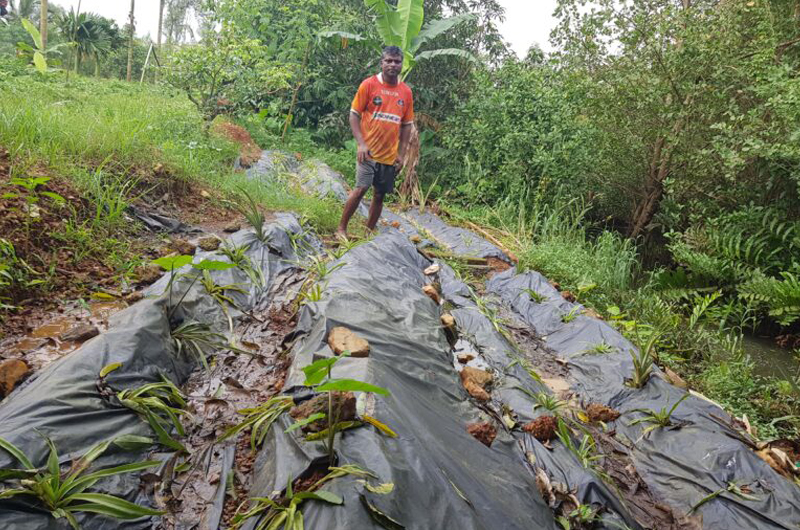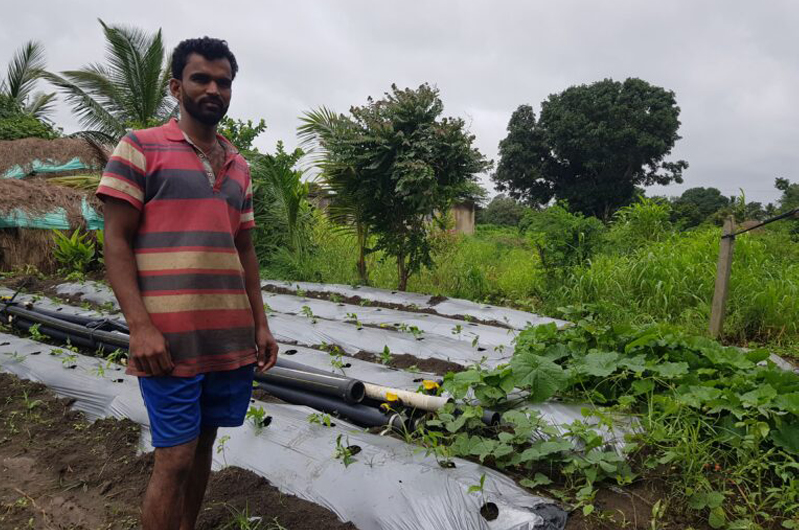Plasti-culture, the application of synthetic polymer-based technologies in agriculture, has found wide ranging uses, making it an integral part of food production in India today. Agricultural plastics are single-use or short-lived, and have been found to be a major source of micro and nano-plastics in the soil, which can have a long term impact on our health and environment. Experts suggest that it is time to recognise the chemical and eco-toxicological aspects of agri-plastics and develop more sustainable alternatives. While plastic-based solutions may improve food production and farmer profitability, Priyamvada Kowshik describes the challenges of retrieving, recycling, and plastic waste management, and wonders whether we are trading short-term agronomic benefits for long-term environmental damage
Sridhar Jayagouda, a young farmer in Alarwada Village on the outskirts of Belagavi City in Karnataka, is preparing for the monsoon crop of paddy by clearing beds of capsicum his family recently harvested. Once the plants are uprooted, he pulls out thin films of plastic covering the raised soil beds. That’s about 40,000 feet or 12 km of single-use plastic mulching sheet from his five-acre farm, every season. “What other alternatives do farmers have?” Jayagouda asks. Plastic mulching is economical, it suppresses weed growth and reduces cost of labour significantly. “Our production has improved,” he says. Like many other farmers in this fertile swath of north Karnataka, Jayagouda adopted plastic mulching and drip irrigation five years ago.
Agriculture today is awash with plastics. Used in applications such as mulch films, shade nets, poly-houses, irrigation pipes, pond liners, and storage silos, plastics are integral to food production, processing, marketing, and consumption. They are also found in polymer-coated agrochemicals. Jayagouda represents a growing number of Indian farmers who have shifted from traditional methods of using biomass mulch and manual weeding to plastic films fitted snugly over raised beds. Mulching, which involves covering soil beds to suppress weed growth, evaporation, and improve the microclimate around the roots, boosts productivity.
The growth of plasti-culture
Plasti-culture is the application of plastics in agriculture. Introduced in India in the 1980s, it has seen exponential growth in the last decade. Plastic mulch, along with drip irrigation, is used in about 90 per cent of ‘protected agriculture’, the cultivation of high-value horticulture crops in greenhouses, according to the agricultural scientists Mongabay India spoke to. Polymer mulch of 15 to 30 micron thickness is among the fastest growing technologies of plasti-culture; it is now being applied in open fields across the country.
For context on thickness, plastic carry bags with thickness less than 120 microns are banned in India, as prescribed by the Plastic Waste Management Amendment Rules, 2021. A one-acre farm requires approximately 8000 feet or 2.4 km of plastic mulch, most of which is single-use plastics. In the long term, the degradation and breakdown of these agri-plastics into micro and nano-plastic particles (MNPs) poses a potentially irreversible threat to food safety and security. Recently, news of the presence of micro-plastics in sugar and salt sold in India made headlines. Although it has raised concerns about quality and regulation, the impact of agricultural production and consumption on micro-plastics in food is not widely discussed.
Food systems are a major driver of plastic pollution. Micro-plastics (diameter less than five millimetres) and nano-plastics (diameter less than one micrometre) are everywhere, accumulating in soil, water, and our food. Historically, micro and nano plastics in the deepest reaches of oceans have been under focus, but now researchers say that MNPs in soil, sediments and freshwater may be an estimated four to 23 times higher, depending on the environment. They have been detected in the tissues and organs of terrestrial and marine life. Researchers warn of potentially life-threatening effects from plastic pollution, with raised risk of stroke and heart attack linked to MNPs in blood vessels. Polypropylene fibres have been found abundantly in human lungs, pointing at inhalation as a route of microplastic exposure; its presence in human faeces has been linked to inflammatory bowel disease; and MNPs were found in all the human placenta tested for a study.
India’s Ministry of Agriculture states that the agricultural plastic industry forecasts the global demand for greenhouse, mulching and silage films to increase by 50 per cent from 6.1 million tonnes in 2018 to 9.5 million tonnes in 2030. In India, the issue of plastic pollution in agriculture has largely been overlooked — plasticulture is being celebrated for its role in ushering in a ‘second green revolution’ in food production. The Indian Government supports this approach by offering 50 per cent subsidies on various plasti-culture applications, particularly to boost horticultural production.

crop. Single-use plastic mulching replacing biomass raises the question of whether we are trading short-term agronomic benefits for long-term
environmental damage.
Climate change as a driver
Adverse climatic events have increased the popularity of plastic use in India, say Indian agricultural scientists. “Plasti-culture technology like micro irrigation with mulching helps farmers combat situations such as heat waves,” says Rakesh Sharda, project coordinator, All India Coordinated Research Project on Plastic Engineering in Agricultural Structures and Environment Management, ICAR-Central Institute of Post Harvest Engineering and Technology, Ludhiana.
However, plastics consist of a complex mix of over 16,000 different chemicals, with around a quarter known to be hazardous to human health. These chemicals can leach out throughout the plastic lifecycle, providing direct pathways for toxic substances to enter the food chain. In plastics in agriculture, this process is influenced by factors such as sunlight, mechanical degradation, exposure to various chemicals and pH levels. Global warming could also exacerbate this. Studies indicate that heat waves hasten polymer degradation and scientists are calling for a revision of polymer safety specifications, so they are more resilient against rising temperatures.
While plastic-based solutions may improve food production and farmer profitability in the short term, the challenge of retrieving and recycling it is enormous, and plastic waste management value chains are poor. For instance, in the absence of an alternative, most farmers, including Jayagouda, burn the plastic mulch films after use, oblivious of the pollutants they are releasing into the air, soil and water in the process.
Food security and environmental safety today face a range of conflicting challenges. “Some plastic applications, such as mulch, can reduce the use of water, pesticides, and herbicides in some cases, and are cost-effective for farmers. However, the impacts on soil health and the subsequent effects on food production, food security, and nutrition are only beginning to gain mainstream attention, and they are raising concerns among policymakers,” says Joe Yates of the London School of Tropical Medicine, who, along with fellow scientist Megan Deeney, is on the Working Group on Food Systems of the Scientists Coalition for Effective Plastics Treaty. With mounting evidence of the adverse impacts of micro and nanoplastics, scientists are urging countries to take action. However, this global call to action to address plastic pollution is in conflict with national agendas focused on increasing food production and farmer income.
More plastics for food security
Feeding a global population expected to reach 10 billion by 2050 exerts a great deal of pressure on the environment. Agricultural production has led to 70 per cent of the groundwater extraction and 75 per cent of deforestation, globally. In India, agriculture presents additional challenges of low productivity, improper use of natural resources, and now, increased frequency of climatic events. Precision agriculture, also known as protected area farming, a farming management strategy that uses technology to improve agricultural production and sustainability, poses a solution.
“Currently, 275,000 ha are covered by precision agriculture in India. Of this, over 90 per cent is covered by plastic mulch, which has seen a steep rise in use in the past decade,” points out Rajesh Kumar Singh, head of department, Hydrology and Engineering, Indian Institute of Soil and Water Conservation, Dehradun. Singh was the former Project Coordinator of All India Coordinated Research Project (Plasticulture Engineering & Technology), ICAR.
The National Committee for Precision Agriculture and Horticulture (NCPAH, earlier known as National Committee for Plasticulture in Agriculture and Horticulture) has the mandate to promote plasti-culture, and recommend suitable policy measures, through various central and state government schemes and mission programmes. Its report on the Impact Assessment of Indian Precision Agriculture and Plasticulture Sector Post COVID-19, reveals that farmers who used plastic mulch reported a 20-30 per cent increase in crop yields, with better quality produce that year. Farmers also reported a “reduction of 90-95 per cent of manual labour for weeding and increase in irrigation interval”.
The multifarious applications of plastics has spawned the growth of micro, small and medium manufacturing units for plasti-culture products. About 50,000 plastic processing plants and 18,000 injection moulding plants are active across India. However information on the regulatory environment is hard to come by. As per a report by the NCPAH, India is the third largest user of plastic after the US and China, even though its per capita consumption of 6 kg (to 9.7 kg in some reports) is lower than the world average of 26 kg. While not all plastics may be replaced with safer and more sustainable alternatives, products like single-use plastic mulching replacing biomass raises the question of whether we are trading short-term agronomic benefits for long-term environmental damage. “Once long-term plastic, micro-plastics, and nano-plastics pollution begins to threaten food security, there may be little chance of recovery. The harms caused by pesticides and herbicides are relatively well understood, but the role of these chemicals in many food system plastics is less recognised,” says Yates, explaining the pathways through which these chemicals of concern enter the environment.

in food production in India, overlooking the level of plastic pollution it is causing in farm lands.
The hidden cost of spotless choice
In Tamil Nadu’s Chengalpattu and Viluppuram districts, watermelon farmers began to adopt plastic mulch once traders began to prefer melons grown on plastic mulch. Ajay T.M., joint managing trustee of Magasool, a Chennai-based trust that works on reducing farm inputs and improving farmer income says, “Ten years ago about 10 per cent of the farmers used plastic mulch, today 60 per cent to 70 per cent have adopted it. Melons develop a discolouration where the fruit rests on soil bunds, which does not occur when bunds are covered in plastic mulch. These spotless fruits are preferred by export markets, and customers,” says Ajay, adding that unless consumer awareness and preference shifts from beautiful-looking produce to chemical-free produce, farmers will comply.
“Agricultural pollution needs the same kind of attention as industrial pollution,” says Soumik Banerjee, member of the Alliance for Sustainable and Holistic Agriculture Kisan Swaraj network. While it may not be possible to replace all plastic applications, Banerjee says that traditional agriculture provides alternative solutions to some. “Practices such as multi-cropping and intercropping are a good alternative to plastic mulching,” he says. As Ajay says, farmers need suitable and sustainable alternatives that don’t impact their incomes or increase labour, and are as effective as plastic. A sustainable solution is in linking agricultural intensification with ecosystem protection, backed by sustainable technological innovation.
(Courtesy: Mongabay India/ india.mongabay.com)



 from Webdoux
from Webdoux